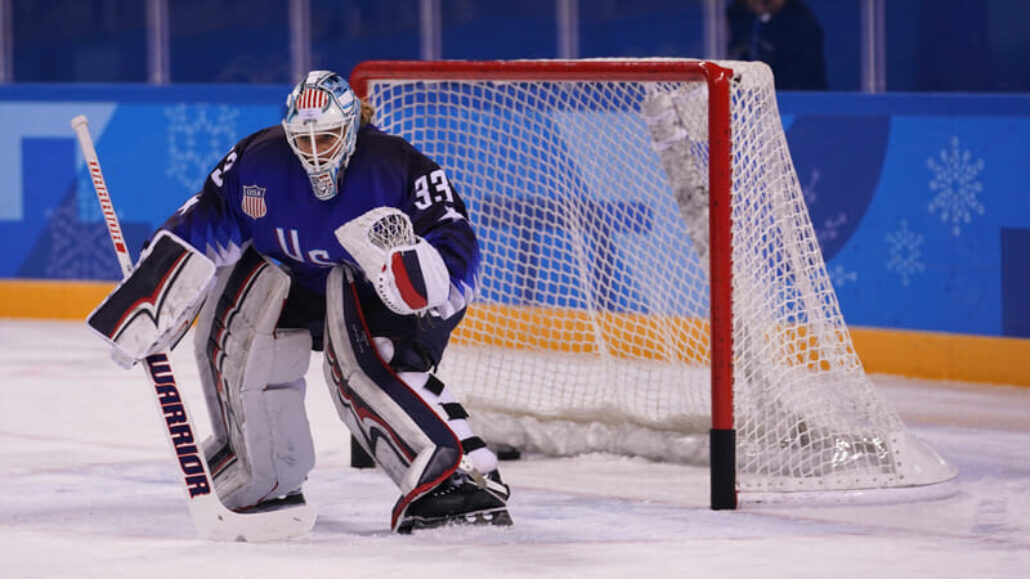As Minnesota celebrates Team USA’s Olympic hockey win, Dr. Skendzel explains the injury risks common to hockey players.
Sports medicine physician Dr. Jack Skendzel celebrated Team USA’s 2018 Olympic hockey gold along with the rest of our country. If he joins our community in being particularly proud of the Minnesota women on the Olympic hockey team, who can blame him? “As the Official Sports Medicine Partner for Woodbury, East Ridge, and Park high schools, I can tell you that high school hockey is really big in Minnesota,” he grins. “I treat a lot of female and male hockey players every year.”
Specific injury risks are shared by high school and Olympic hockey athletes alike
“Hockey players at the high school and college level make up a large percentage of my practice,” Dr. Skendzel points out. “I treat a variety of hockey-related injuries, but there are specific injury vulnerabilities common to male and female hockey players. One of the most common complaints among these patients is hip and groin pain. This issue can be a symptom of hip impingement (FAI) and labral tears.”
Hip labral tears and hip impingement
“The labrum is the ring of cartilage that lines the outside rim of the hip socket,” Dr. Skendzel clarifies. “It cushions the joint and acts to hold the ball at the top of the thigh bone within the hip socket. With repetitive impingement, it can tear. Hip impingement, often referred to as FAI, describes a condition where the ball of the thigh bone doesn’t fit properly in the socket of the hip joint.”
Goalies are particularly at risk for labral tears and hip impingement. “Remember Team USA’s goalie, Minnesotan Maddie Rooney?” Dr. Skendzel asks. “She stopped 29 shots and four of Canada’s six shootout attempts. To do that, she was constantly sitting in a butterfly position: crouched down with her knees and hips bent. Research data suggest that this position can be particularly damaging for hockey players who begin competition at a young age. Over time, that butterfly crouch causes hip pressure that could result in labral tears or impingement.”
Symptoms of labrum injury
Hip injuries are signaled by a variety of symptoms. “Young hockey players describe symptoms including groin pain, clicking, deep hip pain, or pain inside the hip that is worsening with activities,” Dr. Skendzel explains. “The pain might be something that gets worse with practice or after a game. Often, these injuries are misdiagnosed or confused with a hip flexor strain or even a hernia or groin pull. Because of the known risk of hip labral tears and hip impingement in hockey players, I have advice for those athletes and their parents. Sometimes, pain in the groin or hip will get better with rest, ibuprofen, or conservative measures like stretching. If it doesn’t, then it’s time to come in to Summit to get that persistent pain evaluated.”
Timely evaluation matters
“Some injured players are more stubborn than others,” says Dr. Skendzel. “They avoid medical evaluation and try to play through the pain. But time is of the essence with these injuries. Chronic, recurring, or repetitive hip impingement can worsen a labral tear. We’ve seen this in hockey players who have played through groin pain for many seasons; it can do permanent long-term hip damage. I don’t want to be dramatic, but persistent hip and groin pains should not be ignored. In my opinion, it’s much better to have us evaluate your symptoms so we can give proper guidance and care.”
Treatment options for these injuries range from conservative therapies to surgery
“Cortisone injections or physical therapy are often first-line treatments,” says Dr. Skendzel. “However, some patients continue to have groin pain and can’t get back to activities. At that point, impingement and labral tears are treatable with arthroscopic surgery.”
Summit sports resources support robust postsurgical recovery
Following surgery, a hockey player can often get back on the ice fairly quickly. They may be skating at about two months after their surgery. But the return to competitive practice and play takes longer—usually four to six months. “This is where Summit’s ASCEND therapy program is invaluable,” notes Dr. Skendzel. “ASCEND is specifically designed for patients, like recovering hockey players, who are looking for more than routine postsurgical therapy. The ASCEND program is focused on safely getting competitive athletes back to a full level of play.”
Olympic hockey victories may seem miraculous, but hockey safety shouldn’t be
“It did feel miraculous to watch our women’s Olympic hockey team skate to victory this year,” admits Dr. Skendzel. “And how cool was it that their gold medal win came on the anniversary of the 1980 Miracle on Ice?”
If Olympic gold is a once-in-a-lifetime experience, player safety is all in a day’s work at Summit. “We take the well-being of our young hockey players seriously,” says Dr. Skendzel. “When injuries do occur, Summit’s sports medicine team steps up. We offer comprehensive treatment and rehabilitation services to get players safely back to high-level competition.”
Summit Orthopedics offers comprehensive sports medicine expertise
From Olympians to pro athletes to kids in youth sports and those that just want to be more active—Summit Orthopedics delivers expert care by fellowship-trained sports medicine physicians. If you are recently injured or concerned about ongoing pain, Summit Orthopedics sports medicine specialists have the expertise to evaluate your discomfort and develop a plan to quickly and safely help you get back to being active.
Start your journey to stronger, healthier athletic condition. Find your sports medicine expert, request an appointment online, or call us at (651) 968–5201 to schedule a sports medicine consultation.
Summit has convenient locations across the Minneapolis-St. Paul metro area, serving Minnesota and western Wisconsin. We have state-of-the-art centers for comprehensive orthopedic care in Eagan, MN, Vadnais Heights, MN, Plymouth, MN, and Woodbury, MN, as well as several additional community clinics.
Additional resources for you
- Read more about Dr. Skendzel’s experience treating Olympic athletes
- Ask Dr. Skendzel: What Does It Take To Win Olympic Curling Gold?
- Read about Summit’s team approach to recovery after hip surgery
- Watch the video: Meet the Expert: Dr. Jack Skendzel
- Dr. Warner Provides Hip Labral Repair Guidance

